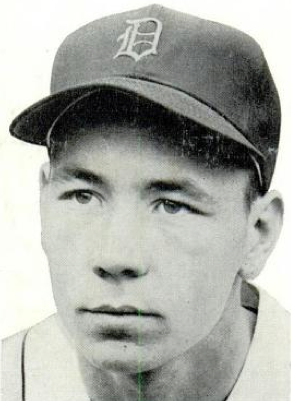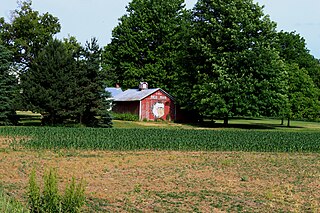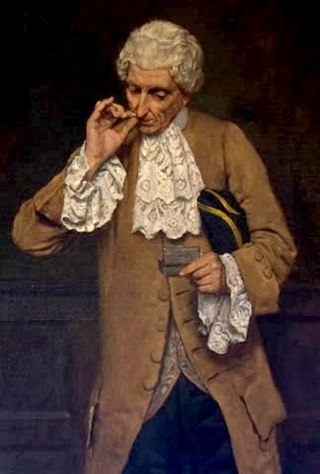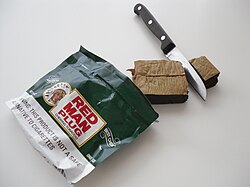
Tobacco is the common name of several plants in the genus Nicotiana of the family Solanaceae, and the general term for any product prepared from the cured leaves of these plants. More than 70 species of tobacco are known, but the chief commercial crop is N. tabacum. The more potent variant N. rustica is also used in some countries.

Gutka, ghutka, guṭkha or betel quid is a chewing tobacco preparation made of crushed areca nut, tobacco, catechu, paraffin wax, slaked lime and sweet or savory flavourings, in India, Pakistan, other Asian countries, and North America.

Snus is a tobacco product, originating from a variant of dry snuff in early 18th-century Sweden. It is placed between the upper lip and gum for extended periods, as a form of sublabial administration. Snus is not fermented. Although used similarly to American dipping tobacco, snus does not typically result in the need for spitting and, unlike naswar, snus is steam-pasteurized.

William Robert Tuttle was an American professional baseball player. Primarily a center fielder, he appeared in 1,270 games played in Major League Baseball over 11 seasons for the Detroit Tigers, Kansas City Athletics (1958–1961) and Minnesota Twins (1961–1963). Tuttle also played 85 games as a third baseman during 1961 for the Twins; they were the only MLB games he ever played at the "hot corner." He threw and batted right-handed, stood 6 feet (1.8 m) tall and weighed 190 pounds (86 kg).

America's Best Chew is an American brand of chewing tobacco which was first introduced in 1904.
Dipping tobacco is a type of finely ground or shredded, moistened smokeless tobacco product. It is commonly and idiomatically known as "dip". Dipping tobacco is used by placing a pinch, or "dip", of tobacco between the lip and the gum. The act of using it is called dipping. Dip is colloquially called "chaw", "snuff", "rub", or "fresh leaf" among other terms; because of this, it is sometimes confused with other tobacco products—namely nasal/dry snuff.

N-Nitrosonornicotine (NNN) is a tobacco-specific nitrosamine produced during the curing and processing of tobacco.

U.S. Smokeless Tobacco Company is an American company that manufactures smokeless tobacco products, notably dipping tobacco, as well as chewing tobacco, snus, and dry snuff. The company is a subsidiary of Altria.

Smokeless tobacco is a tobacco product that is used by means other than smoking. Their use involves chewing, sniffing, or placing the product between gum and the cheek or lip. Smokeless tobacco products are produced in various forms, such as chewing tobacco, snuff, snus, and dissolvable tobacco products. Smokeless tobacco products typically contain over 3000 constituents. All smokeless tobacco products contain nicotine and are therefore highly addictive. Quitting smokeless tobacco use is as challenging as smoking cessation.
Herbal cigarettes are cigarettes that usually do not contain any tobacco or nicotine, instead being composed of a mixture of various herbs and/or other plant material. However, Chinese herbal cigarettes contain tobacco and nicotine with herbs added, unlike European and North American herbal cigarettes which have tobacco and nicotine omitted. Like herbal smokeless tobacco, they are often used as a substitute for standard tobacco products. Herbal cigarettes are often advertised as a smoking cessation aid. They are also used in acting scenes by performers who are non-smokers, or where anti-smoking legislation prohibits the use of tobacco in public spaces. Herbal cigarettes can carry carcinogens.

Snuff is a type of smokeless tobacco product made from finely ground or pulverized tobacco leaves. It is snorted or "sniffed" into the nasal cavity, delivering nicotine and a flavored scent to the user. Traditionally, it is sniffed or inhaled lightly after a pinch of snuff is either placed onto the back surface of the hand, held pinched between thumb and index finger, or held by a specially made "snuffing" device.

The American Snuff Company, formerly Conwood Sales Company LLC, is a US tobacco manufacturing company that makes a variety of smokeless tobacco products, including dipping tobacco or moist snuff, chewing tobacco in the forms of loose-leaf, plug, and twist, and dry snuff.
Oliver Twist is a brand name of smokeless tobacco manufactured by House of Oliver Twist of Odense, Denmark.
Tobacco-specific nitrosamines (TSNAs) comprise one of the most important groups of carcinogens in tobacco products, particularly cigarettes and fermented dipping snuff.
Dissolvable tobacco is a tobacco product that dissolves in the mouth. Major tobacco manufacturers that sell dissolvable tobacco products include R. J. Reynolds Tobacco Company. Research into health effects of dissolvable and other new tobacco products was among the reasons of the establishment of the Tobacco Products Scientific Advisory Committee of the Food and Drug Administration in 2009.
Tobacco usage in sport is a well documented and publicised occurrence. Tobacco advertising has connected itself to sports both for the connotations of health that sports provide, as well as the marketing potential of famous athletes. Additionally, tobacco has played a role in the sport of baseball specifically and has affected both the rules affecting players and fan alike. Agencies such as the CDC have used sports as platforms for tobacco prevention programs, specifically targeted at younger people.
Tobacco is an agricultural product acting as a stimulant triggering complex biochemical and neurotransmitter disruptions. Its main ingredient is nicotine and it is present in all cigarettes. Early tobacco usage was for medical cures and religious purposes. In the early 1900s, cigarette usage became increasingly popular when it was sold in mass amounts. In 1964, the Surgeon General of the United States wrote a report concerning the dangers of cigarette smoking. In the United States, for the past 50 years efforts have been made so that the public should be aware of the risks of tobacco usage.
Smokeless tobacco keratosis (STK) is a condition which develops on the oral mucosa in response to smokeless tobacco use. Generally it appears as a white patch, located at the point where the tobacco is held in the mouth. The condition usually disappears once the tobacco habit is stopped. It is associated with slightly increased risk of mouth cancer.

Nicotine pouches, also called modern oral nicotine products, are white pouches containing nicotine among other ingredients. They do not include tobacco leaf, dust, or stem. The nicotine may either be derived from tobacco plants or may be synthetic. Nicotine pouches are described as either similar to or a tobacco-free version of snus.















